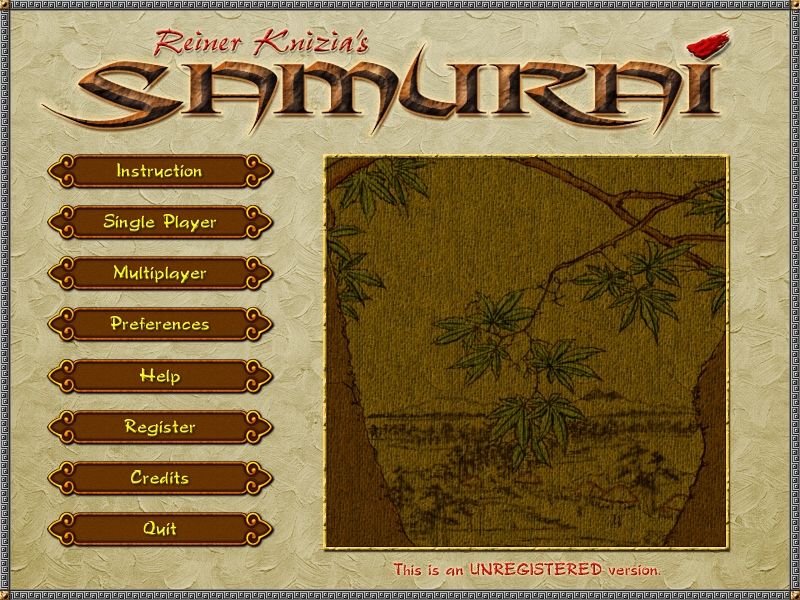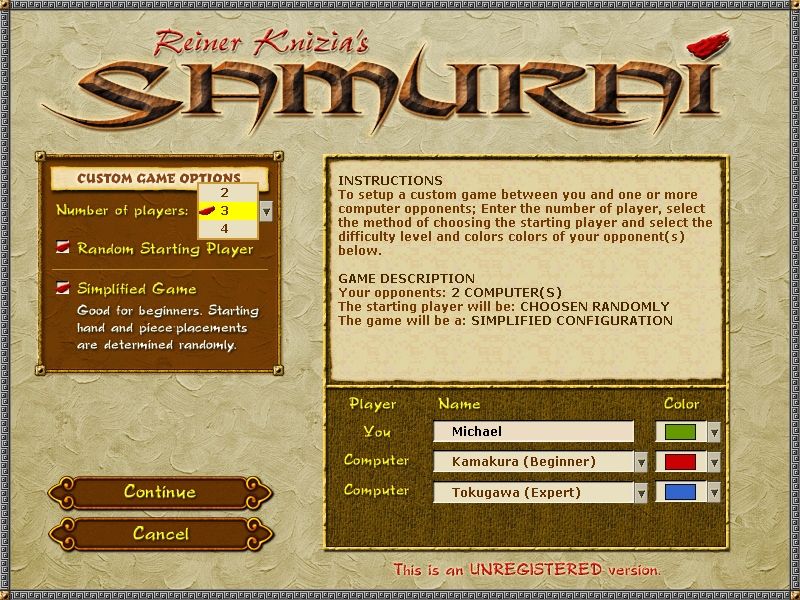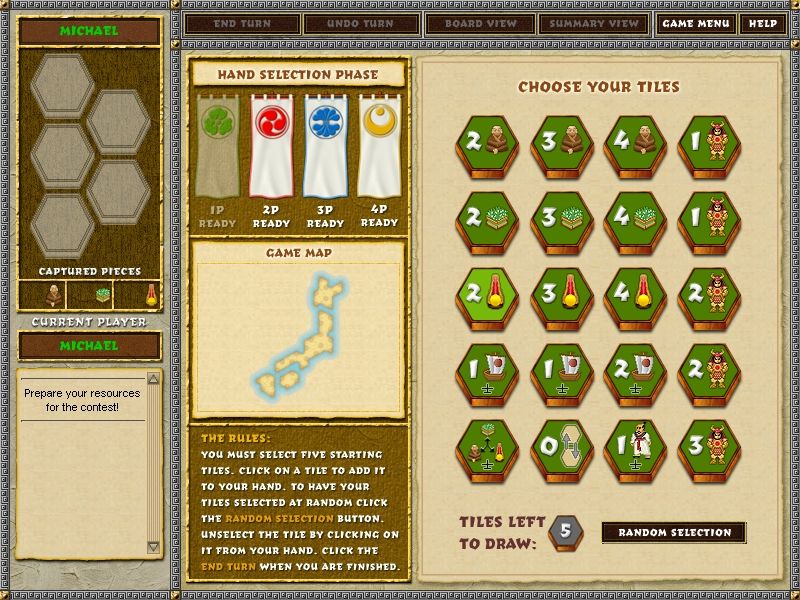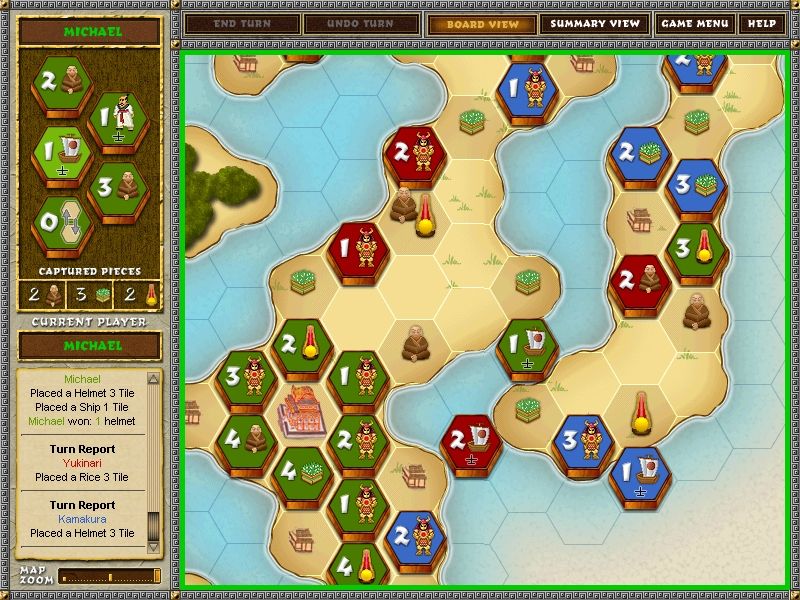Retro Replay Review
Gameplay
Reiner Knizia’s Samurai brings the acclaimed board game into a digital format with faithful adherence to its strategic core. The gameplay revolves around placing tiles on a hexagonal map of pre-unification Japan to sway cities toward your cause. Each turn, players choose from a deck of slow and fast tiles, with the slow tile count capped at one and unlimited fast tiles, creating a unique pacing that balances long-term planning and opportunistic placements.
The heart of the strategy lies in the three caste-symbols—Clergy (Buddha), Nobility (helmet), and Peasants (rice)—that populate each city. By aligning your tiles with the matching symbol adjacent to a city, you gradually tip the influence scales in your favor. When a city is completely surrounded on land, the tiles’ values are totaled, and control of the city’s pieces is awarded to the highest bidder. This mechanic rewards careful tile management and spatial awareness, as neighboring players can contest your influence at any moment.
Beyond the standard tiles, special tiles such as Samurai, Ronin, and ships introduce tactical depth. Samurai and Ronin tiles bolster your influence across all castes, while ships uniquely allow you to project power over waterways. Exchange tiles recover used tiles back to your hand, and piece-swap tiles enable you to rearrange the board’s power dynamics by relocating caste pieces between cities. These mechanics combine to keep each match fresh and unpredictable.
Samurai offers two distinct modes: Classic, which emphasizes the original board game’s victory conditions, and Domination, which speeds up play by adjusting winning thresholds. Both modes support up to four players, either in local pass-and-play or online multiplayer. A robust AI fills in for solo play, providing multiple difficulty levels that challenge both newcomers and seasoned veterans of tile-based strategy games.
Graphics
Visually, Samurai retains the minimalist elegance of its board game roots. The hex grid is rendered cleanly with subtle textures that evoke parchment and rice paper, immersing players in a stylized vision of feudal Japan. Each caste icon—Buddha, helmet, rice sheaf—is crisp and easily distinguishable, ensuring that even on smaller screens you can quickly interpret the board state.
Tile placement animations are smooth and deliberate, giving weight to every move without dragging down the game’s pace. Special tiles like ships animate with rippling water effects, while Samurai and Ronin tiles feature bold brushstroke motifs that highlight their importance. The result is a user interface that feels alive yet never overwhelms, keeping focus squarely on strategic choices.
The color palette leans on earth tones—burnt umber, moss green, muted gold—creating a harmonious backdrop for the more vibrant tile icons. This design choice not only honors the thematic setting but also enhances readability, as each player’s tile colors and symbols stand out clearly on the map. Whether you’re playing on a desktop monitor or a tablet, the graphics strike an appealing balance between aesthetic refinement and functional clarity.
Additional visual flourishes, such as subtle soundscapes and occasional weather effects, further deepen the ambiance without distracting from the core gameplay. These sensory touches, while modest, demonstrate an attention to detail that elevates the digital adaptation above mere board-to-screen translation.
Story
While Samurai is light on narrative in the traditional sense, its setting in pre-unification Japan provides a rich historical backdrop that informs its strategic stakes. You assume the role of a warlord vying to unite various provinces under your banner. This loose framing grants context to the tile-placement battles over cities and emphasizes the competitive jockeying among rival clans.
Dialogues and flavor text are sparse but effective, offering brief insights into the ambitions and rivalries of neighboring warlords. These snippets convey the tension of the era without bogging down gameplay with lengthy cutscenes or role-playing mechanics. Instead, the story unfolds through map control, letting you feel the rise and fall of influence as provinces slip through your fingers or rally to your cause.
The lack of a linear campaign allows for high replayability: every match presents a different map layout, opponent mix, and tile draw sequence. Although some players seeking a deep narrative arc might miss a dedicated story mode, the game’s thematic consistency and the evocative art style fill that gap by immersing you in a believable feudal conflict.
Ultimately, the “story” of Samurai is one you craft through your strategic decisions. Each tile placement shapes the unfolding drama of alliance, betrayal, and conquest, inviting you to write your own saga on the hexagonal battlefield.
Overall Experience
Reiner Knizia’s Samurai stands out as a sterling example of how to adapt a complex board game into an engaging digital experience. The core mechanics translate seamlessly to the screen, and the streamlined interface ensures that rule clarifications or bookkeeping distractions are kept to a minimum. This allows both newcomers and series veterans to dive right into the strategic fun.
The dual game modes and flexible player counts make Samurai ideal for quick solo sessions, multiplayer nights, or online showdowns with friends around the world. The AI’s adjustable difficulty keeps single-player matches challenging without ever feeling unfair, while the online matchmaking and pass-and-play options cater to various playstyles and schedules.
Graphically and thematically, Samurai nails its historical ambiance without sacrificing readability or accessibility. The balanced combination of standard and special tiles ensures that no two games feel alike, and the tension of city sieges—of surrounding hexes, counting influence, and racing for control—delivers satisfying climaxes turn after turn.
Whether you’re a strategy enthusiast seeking a refined tactical challenge or a board game fan curious about a faithful digital conversion, Samurai offers a compelling package. Its elegant design, strategic depth, and polished presentation come together to create an experience that’s as rewarding as it is replayable.
 Retro Replay Retro Replay gaming reviews, news, emulation, geek stuff and more!
Retro Replay Retro Replay gaming reviews, news, emulation, geek stuff and more!









Reviews
There are no reviews yet.